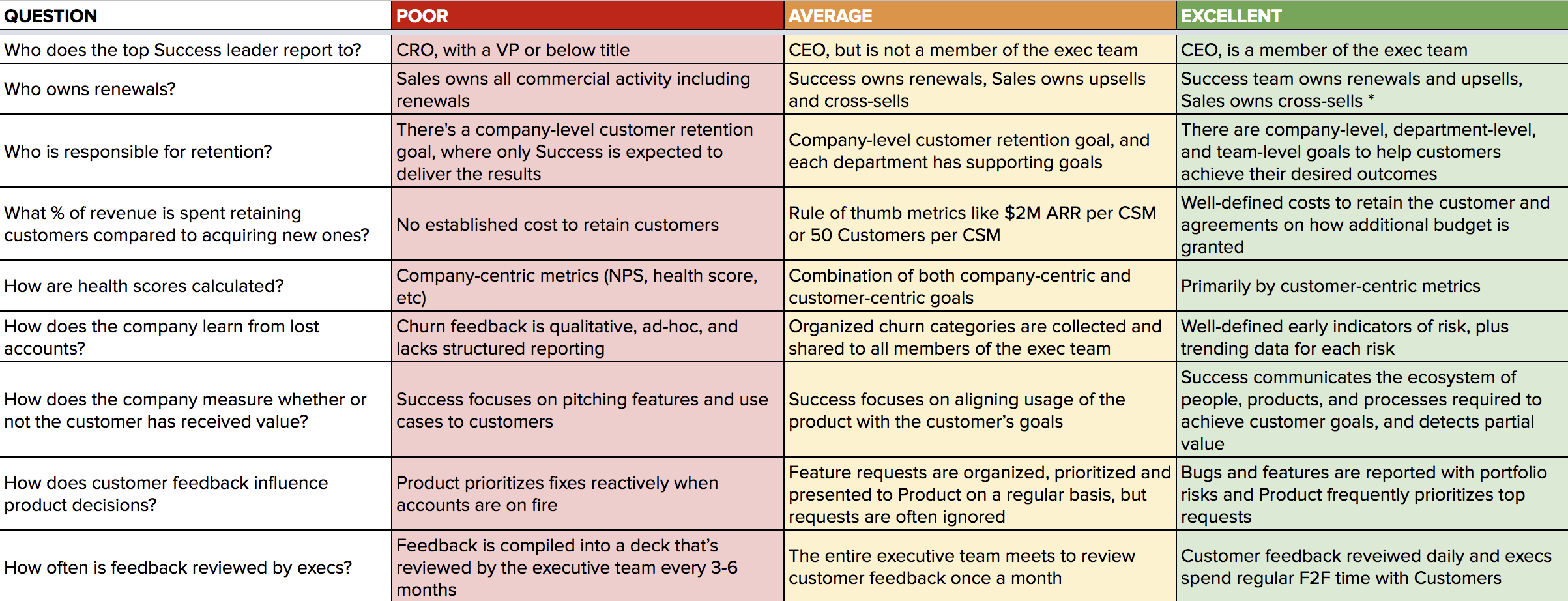An excerpt from:
Everyone says they value customer success. These 9 questions verify if it's true
Customer Success understands the customer better than any other function in the organization. And yet, in many companies, the team doesn’t have the strategic influence to help customers be truly successful.
One of my greatest frustrations is when a company says they value their customers, but their actions say otherwise.
So we created a scorecard that Success leaders can use to see how much their companies really value their customers—and the Customer Success function specifically. The “poor, average, excellent” scales provide a path for leaders to advocate for their group and to put the customer at the center of the business.
Click on the image to expand in a new window
Here’s the TL;DR on 3 of the 9 questions:
1. Who does the top Success leader report to?
If the top Success leader is a VP (or below VP in smaller companies), if they report to anyone but the CEO, or if the role doesn’t exist at all, this is the first indication that a company might not prize the opinion of the customer to the fullest extent.
In excellent companies, the top Success leader reports to the CEO and is equal to their peers on the executive team. Here, these leaders can bring their deep insights about the customer to influence strategic decisions across the company.
2. Who is responsible for retention?
The best SaaS companies are documenting the customer’s desired outcomes, and there are company-level, department-level, and team-level goals to help the customer achieve those outcomes.
In contrast, many organizations have a company-level retention goal but only Customer Success is expected to deliver the results. When the customer journey includes touchpoints across Marketing, Sales, and Product, but these groups aren’t being held accountable for the experience they’re providing, that indicates the company isn’t focused on investing in their customers.
3. How often is feedback reviewed by execs?
Executive team culture around customer feedback is often a defining characteristic of a company’s culture and whether or not they follow through on their “Customer comes first” core value.
Poor companies have a leadership team that reviews feedback every 3-6 months. In great companies, they review customer feedback daily.
You can read the full framework here. Many thanks to Jay Nathan and Jeff Breunsbach of Customer Imperative for collaborating on this piece.

The top articles this week:
This week's newsletter features posts on:
- Tales & Trends of Startup Resilience
- The Best Place for Upsells to Live
- 4 Laws of Customer Success
- The Manager's guide to Inclusive Leadership
COVID-19
Tales & Trends of Startup Resilience
Here’s a report based on interviews with 60+ founders and VCs on the strategies they’ve employed to survive and grow during this time. One of the takeaways: “Customers are now dictating the Product roadmap.” Product teams need to “move from ‘push’ to ‘pull’” and “respond to the highest need first.”
If you enjoyed reading the report from Will Reed, see Openview’s annual SaaS Product Benchmarks Report which was released this week.
STRUCTURE
Where's the Best Place for Upsells to Live?
A LinkedIn post from the Gain Grow Retain team that offers starting points for creating engagement models for SMB, mixed, and enterprise customer tiers.
WORKFLOW
4 Laws of Customer Success
Russ Drury, Manager - Strategic Customer Success at InVision, explains how four well-known theories apply to Customer Success. He calls out Miller’s Law, for example, which suggests that the average person can only keep ~7 items in their working memory at a time—and then explains how CSMs ought to prioritize their time with that in mind.
MANAGEMENT
The Manager's Guide to Inclusive Leadership—Small Habits That Make a Big Impact
“You can’t just assume inclusion will sprout organically once you’ve introduced more diversity.” This piece breaks down the “four essential habits” of inclusive leadership. It’s packed with immediately-actionable advice and tactics, like encouraging team members who are remote or more introverted to participate in discussion by 1. creating thinking time, 2. doing a timed round-robin, and 3. ending meetings with ritual questions.


Submit a comment